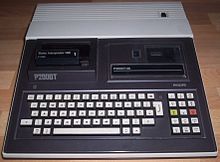Philips P2000
The P2000 desktop series was Philips ' first attempt to gain a foothold in the home computer market after the Videopac G7000 . In March 1980 the two versions P2000M and P2000T were released. From 1983 the model P2000 C was presented.
The main difference between the "M" and "T" versions was the video interface . The T version, which was intended for home and educational use, could to a TV or an RGB - Monitor can be connected. The video chip of this version was a chip for teletext , which was relatively cheap, but very limited the graphics capabilities. The more professional M version had an additional 80-character card, so that it could be connected to a monochrome monitor. This version was sold together with a monitor, the housing of which also had space for two 5.25 " floppy disk drives . This could also be used to run CP / M as the operating system . There was no built-in programming language , as the 4 kB ROM was only a basic system and Two places for plug-in modules made it possible to expand the computer with ROM modules (slot 1) or interface cards (slot 2), such as a modem or a printer interface . A BASIC could also have such a plug-in module Due to the different video interfaces, the T and M versions were not 100% compatible with each other .
Programs and data could be stored on a built-in mini-cassette drive with a capacity of 42 kB. This drive was seen by the user as a floppy disk drive with automatic search for a program (CLOAD command) and determination of the available free memory (CSAVE command). A command made it possible to display the table of contents of a cartridge.
The P2000 did not have much success in Europe . The computers were manufactured in Austria . The computers found a certain distribution in Dutch and German schools .
Technical specifications
- Year of publication: 1980
- Manufacturer: Philips
- Processor : Zilog Z80 , 2.5 MHz
- ROM : 4 kB
- RAM : 16 kB
- Operating system : own, CP / M
- Text: 40 × 24
- Colors: 7
- Sound: mono (internal)
- internal drives: mini-cassette (42 kB)
- Interfaces : 2 × plug-in module , RS232 , RGB , HF modulator
The P2000 C model was introduced in 1983. It was a portable version with two floppy disk drives with 320 kB or 640 kB capacity. As a special feature, the device was designed to be portable with an integrated 9-inch monochrome monitor. The keyboard was designed as a cover. Various companies offered conversion versions with hard drives (5–20 MB capacity). This version had the hard drive installed instead of the monitor, so that a larger external monochrome monitor could be connected. The CP / M was initially intended as the operating system, but there were also extensions with a 16-bit processor on which a DOS version could then run. Wordstar and Calcstar were supplied as software as standard, which allowed a certain professional use. A version of Texas Instruments was also offered, a word processor that could calculate within the text. B. allowed the creation of invoices.
- Year of publication: 1983
- Manufacturer: Philips
- Processor : Zilog Z80 , 8-bit
- ROM : 16 kB
- RAM : 64 kB
- Operating system : own, CP / M or DOS
- Text: 80 × 24
- Colors: monochrome
- Sound: mono (internal)
- internal drives: 2 * floppy disk drive 5.25 "
- Interfaces : 2 × plug-in module ,
- Software: Wordstar, Calcstar, chess, file transfer, various others
